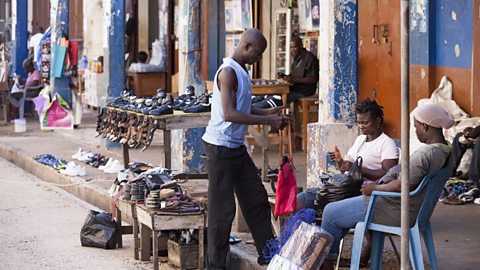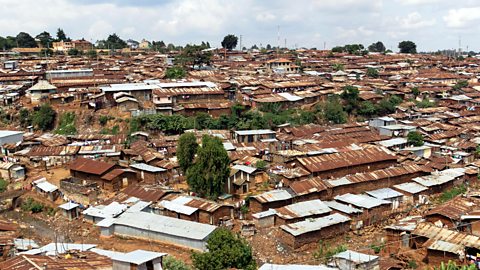Formal and informal economies
low income country (LIC)Based on the World Bank's income classifications, a LIC has a gross national income (GNI per capita) of $1,045 or lower. (LICs) have very different economies to high income country (HIC)A country with a gross national income per capita above US $12,735 (according to the World Bank) such as the Netherlands and the UK. (HICs). In HICs many people have formal jobs in which they have set hours, a monthly wage, healthy working conditions and they pay tax.

In LICs, some people also have formal jobs but large numbers of workers have informal jobs. These jobs are often unskilled and labour intensive, require little money to set up, offer no protection to the workers and they pay no tax. Examples include street sellers, minibus drivers, money changers and market traders. These jobs form part of the informal economy which is also called the grey economy.
Case study: Kenya
Kenya lies along the Equator on the east coast of Africa, next to the Indian Ocean. The capital city is Nairobi. It has a population of over 53 million people. It is a very diverse population with over 40 ethnic groups including the Kikuyu, Luo and Maasai.
Kenya is an example of a low-income country. Gross National Income (GNI) per capitaA measure of the total income of a country, divided by the number of people in that country. (GNI) is $1,840 per person compared to $39,830 per person in the UK. Life expectancy is 67, infant mortality 31 per 1,000, 72% of the population live in rural areas, most are small-scale farmers and most live in poverty.
There is a wide gap in income between people living in the drought-prone north-eastern lowlands, the highlands to the south-west, the coastal strip and the slum dwellers in Nairobi.
Coastal strip
- Hot and humid climate with cooling sea breezes.
- Important port of Mombasa with trading links across the Indian Ocean.
- Many international tourist resorts such as Mombasa and Lamu.
- Swahili and Mijikenda ethnic groups form the majority of the population.
- 3 million people live in this region, most in poverty.
- Fishing industry is important along the coastline in villages such as Kilifi.
- Maize and cassava are the staple foods grown in the area.
- Malnutrition is common.
- Access to the region via international airport.
South-west
- Highland area with cooler temperatures.
- Reliable rainfall with two rainy seasons.
- Fertile soils growing crops such as tea, coffee, sisal and wheat.
- Majority of Kenya's settled population live here.
- One of the most successful agricultural regions in Africa.
- Capital city Nairobi with international links.
- Flowers grown as an important cash crop.
- Soda ash mined near Nairobi.
North-east
- Nomadic herdsmen, such as the Maasai, live here with their cattle.
- Semi-aridExtremely dry. savanna lands, not suitable for settled agriculture.
- Variable rainfall, less than 250 mm per year.
- Poverty and food insecurity are severe.
- Severely affected by recurrent droughts.
- Suffers from soil erosion and desertification.
- Droughts and floods have increased in frequency and intensity over the last decade. Severe drought occurred in 2021 and 2022, with around 4 million people requiring food assistance.
- It is and has historically been primarily inhabited by ethnic Somalis.
Slums of Nairobi
- 2.5 million people live in the slums, 60% of the population of Nairobi.
- Kibera is the biggest slum in Africa with 250,000 people living there.
- 90% of people live in shacks built on land that they do not own.
- The dwellings are very small (3.5 m × 3.5 m) and often house eight or more people.
- Many tribal groups from different rural areas live in close proximity to each other - this can sometimes result in tensions.
- 80% of Kibera has no electricity and until recently there was no running water. People have to use unclean water from the Nairobi dam, leading to typhoid and cholera.
- Recently the World Bank and the municipal council provided two water pipes in the slum.
- There are no clinics or hospitals, medical help is provided by non-governmental organisation (NGO)A company that does not work for the government, eg a charity..
- Unemployment is high (estimated at 50%).
